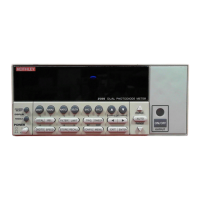8-6 Data Store Models 2500 and 2502 User’s Manual
Using :READ? to store data
Use :TRIG:COUN <n> to set the number of readings to be stored (n = number of read-
ings; 3000 maximum). Use the :FORM:ELEM CURR1 | CURR2 to select the channel.
Turn on the output with :OUTP1 ON or :OUTP2 ON and then send the :READ? command
to trigger and access readings. (Once you access these readings, you will still be able to
access previously stored :TRACe buffer readings using :TRAC:DATA?.) See Section 10
and Section 17, “Trigger subsystem,” for triggering details, and Section 16 for information
on the :READ? command.
Remote command data store
Data store commands
Table 8-1 summarizes commands associated with data store operation. See Section 17,
“TRACe subsystem,” “DISPlay subsystem,” “FORMat subsystem,” and “CALCulate8,”
for more detailed information on these commands.
Table 8-1
Data store commands
Command Description
:TRACe:DATA?
:TRACe:CLEar
:TRACe:FREE?
:TRACe:POINts <n>
:TRACe:POINts:ACTual?
:TRACe:FEED:CONTrol <name>
:TRACe:TSTamp:FORMat <name>
:CALCulate8:FORMat <name>
:CALCulate8:DATA?
:FORMat:ELEMents:TRACe <name>
:DISPlay:MODE <name>
Read contents of buffer.
Clear buffer.
Read buffer memory status.
Specify buffer size (n = buffer size).
Query number of stored readings.
Start or stop buffer. Name = NEXT (fill buffer and stop) or NEVer
(disable buffer).
Select timestamp format. Name = ABSolute (reference to first
buffer reading) or DELTa (time between buffer readings).
Select buffer statistic (name = MEAN, SDEViation, MAXimum,
MINimum, or PKPK).
Read buffer statistic data.
Select buffer data elements. Name = CURRent[1], CURRent2,
CALCulate1, or CALCulate2, CALCulate3, CALCulate4,
CALCulate5, CALCulate6, CALCulate7, TIME, STATus, ALL,
or DEFault (CURRent[1] or CURRent2).
Select CALC8:DATA? source. Name = CALC3, CALC4,
CALC5, or CALC6.
Test Equipment Depot - 800.517.8431 - 99 Washington Street Melrose, MA 02176
TestEquipmentDepot.com

